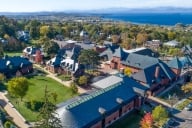You have /5 articles left.
Sign up for a free account or log in.
It's almost May, which means that the classes are winding up, and the students are winding down, and the faculty are wending away. The campus will belong to us Morlocks (I mean ... staff members) again, and not a minute too soon.
Summer is when the big projects get done on Greenback's campus -- significant modifications to buildings, and grounds, and facilities. Not the huge new construction projects -- those take years. And not the quick-and-dirty jobs that can get done over Spring Break, or maybe Intersession. But there are lots of remodeling projects, or partial building rehabs, or systems enhancement efforts which can get done in 3-month timeframes, or which can get sliced up into sections each of which can get done in a 3-month timeframe.
This is hardly new, but the advent of campus sustainability efforts has added another layer to many of these summer projects. Improving insulation, or lighting, or heating and ventilation; swapping all the shower heads on campus, or all the toilets in a residential college; changing the landscaping on the quad so that it needs mowing less often and fertilization not at all -- these are efforts which might not have been at the top of the list in years past, but which rate higher priorities in times like these.
Many of these jobs will not only save energy (in some form or other), but also money. Some of them (like the low-maintenance quad) will also save labor. But a few may present trade-offs, saving in one area but costing in another. A simple (and completely theoretical, at least for now) example:
Let's say Greenback has some high pressure outside lights (which, in fact, it does). And let's say that LED technology has advanced far enough that we consider replacing some of those lamps with LED fixtures -- at least on a pilot basis. This might lead to a significant savings in energy consumption, and thus in greenhouse gas emissions. And there should be some maintenance savings -- the old fixtures required bulb replacement at some interval, whereas the LEDs should last far, far longer. Sounds like a win/win, right?
But remember that Greenback is in the northeastern USA. We get snow here through much of the academic year. In fact, we get a lot of snow, and a lot of differing kinds of snow, under a lot of differing wind and weather conditions. Sometimes the snow (wet, sticky, and wind-blown) covers the streetlamps, turning what was once a bright beacon into a small, slight glow. With the high pressure fixtures we now use, that's not a problem (at least, not for long). The lamp gets hot (where did you thing all that energy was going?), the snow melts and falls away, and -- voila! -- problem solved.
But LEDs don't get hot. LED fixtures can't be expected to melt off snow cover as fast, or as thoroughly, as did older, less efficient, lamps. Some manufacturers may address this with controllable heating elements built into the cowling, but probably not all. Other companies may figure out how to design the entire structure so that snow doesn't stick to it or, if it does stick, doesn't impede the light-flow much. (Part of the reason this is theoretical is that I don't claim to know the specifications and features of every commercial LED product out there -- it's a rapidly evolving market.) But until the perfect outdoor LED fixture for our needs shows up on the loading dock, Greenback may have to decide between using an inefficient light which clears itself of snow and an energy-efficient lamp which doesn't.
When that's the case, part of my job is to argue for the more energy-efficient lamp, even if it's arguably less labor-efficient. Clearing lamps of snow with a long-handled brush and some "elbow grease" may be old-fashioned, but it puts less CO2 into the atmosphere than does the electricity which now heats our outside lights whether it's snowing or not.





